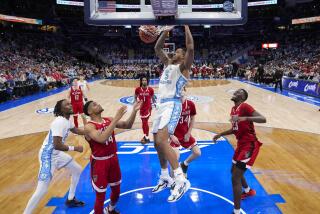Maryland Aims for Final Four
- Share via
After losing to Maryland on Saturday at Cole Field House, Florida State Coach Pat Kennedy made his point about as simply as it could be made: “That team is a Final Four team.”
How sweet. How simple.
And how correct.
No, that doesn’t mean Maryland’s fans should run out and buy nonrefundable plane tickets to Seattle. The Terps will have to keep playing well up until the NCAA tournament, avoid the inevitable tumble of early-round upsets and probably beat at least one opponent that is every bit their equal in a regional final. That’s hardly a sure thing.
But Kennedy didn’t mean to suggest that the Terps were going to make the Final Four, period. No one can say that about any team a full month before the tournament’s first dribble. What Kennedy meant was that the Terps were capable of making the Final Four. And that is as true as Joe Smith’s name is dull.
For the first time in 15 years, since Buck Williams and Albert King were around, the Terps can get there. It’s not a stretch. They’re among the small fraternity of teams with the wherewithal to reach the Final Four. It isn’t some dreamy proposition this year, not some flight of fancy intended only for the better teams to take seriously. It’s a real goal, as tangible and legitimate as a dunk in your face.
Even though the Terps made it to the Sweet 16 a year ago, they weren’t ready to win the next two games they needed to win to make the Final Four. They were too young, too inconsistent, too reliant on their inside game. In the end, they were pretenders looking up at such contenders as Arkansas, Michigan, Arizona and Duke.
This year, they’re among the contenders, the half-dozen or so teams looking down at everyone else. Massachusetts, Arkansas, Kentucky, Kansas, Connecticut and North Carolina are the chalk. The Terps belong in their company. Last week’s upset of Carolina was the final proof.
Arkansas and Connecticut may have more depth and experience, Kentucky may have more firepower, Kansas may have more self-confidence and Massachusetts with a healthy Marcus Camby may have more everything than everyone else, but none is an unbeatable, team-of-the-century team, and the Terps have enough balance and talent to play with them all. And sometimes win.
In other words, there is no limit to what they can accomplish.
Of course, the Final Four is not limited to teams that are highly ranked during the season. The foundation of the NCAA tournament’s appeal is its ability to surprise. Final Four teams can come from far down in the rankings, too. Villanova was an eighth seed in 1985, LSU an 11th seed in 1986. Few office-pool entries had Florida making it a year ago, no doubt.
Still, despite the ballyhoo given to its annual run of upsets, the tournament plays much closer to form than you would think. Quality does count for something. Of the 40 teams to make the Final Four in the past decade, 27 were seeded first or second in their regionals. The figure jumps to 32, or 80 percent of the group, if you include third seeds.
In other words, the vast majority of teams making it to the Final Four come from the small pool of teams you thought should make it. And the Terps are in that pool this year. Unless they slump badly in the next few weeks, they figure to end up seeded no lower than third even if they don’t win the ACC regular-season championship or postseason tournament. And if they win one of those titles, they’ll be seeded second or first.
But no matter where they’re seeded, their goal of making it to Seattle is real, reachable. The moment should not be taken for granted. It doesn’t occur that often. Len Bias never had enough help. The Mustaf-Massenburg-Walt Williams teams never had enough talent.
They know how to finish strong, and they know how to win ugly, two qualities that are critically important in March, when nerves often jumble stomachs. And they have learned how to win without Joe Smith’s playing a central role.
More to Read
Go beyond the scoreboard
Get the latest on L.A.'s teams in the daily Sports Report newsletter.
You may occasionally receive promotional content from the Los Angeles Times.










